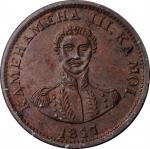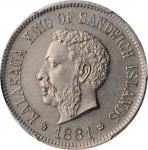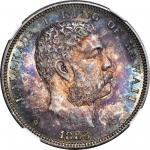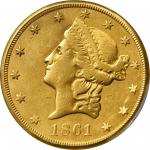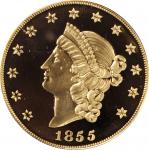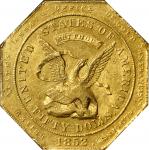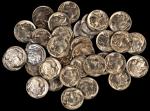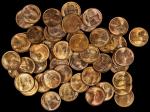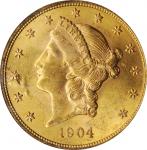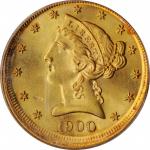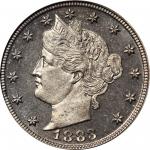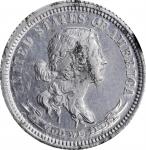LOT WITHDRAWN Approximately 55 mm x 111 mm x 38 mm. Bright yellow-gold with areas of thin mottled orange and reddish-brown patina that formed over more than a century on the Atlantic floor off the coast the Carolinas. The bottom of the bar seems actually toned, with lovely pastel rose and golden-green iridescence in places. Stamped on the face with the serial number at the top, above the large prepared punch featuring an unusually complete expression of the assayers firm name, in four lines, KELLOGG / & / HUMBERT / ASSAYERS within a rectangular frame. Below this punch is the weight in ounces, the fineness and the face value in 1857. All numbers were applied by individual numeric punches, the other elements by gang punches. The opposing side (actually the top, as poured) features a deep and smooth cooling depression with the serial number prominently stamped at one end. A pair of assay corner clips are at opposing corners.<p>The Kellogg & Humbert bars are the most plentiful of those recovered from the <em>S.S. Central America</em> but they also carry the best numismatic ties as the circulating gold coins issued by Kellogg & Company, and August Humbert, in his capacity as the United States Assayer of Gold at San Francisco, are their direct cousins. This said, the coins were meant to circulate while bars like this were simply produced to easily account for and transport large quantities of gold. They were never meant to survive, but fate stepped in, allowing historians, researchers and collectors the incredible opportunity to study, own and enjoy these remarkable artifacts of Gold Rush-era finance. It is plated on page 438 of Q. David Bowers <em>A California Gold Rush History featuring the treasure from the S.S. Central America</em>.<p><strong>THE SHIP OF GOLD</strong><p>The story of the Ship of Gold, the <em>S.S. Central America</em>, is unique in American history. The sidewheel steamer set sail from Panama in early September 1857, headed north to New York City. Aboard was $1.6 million in registered gold coins and ingots at a time when gold was valued at $20.67 per ounce. The treasure had left San Francisco aboard the <em>S.S. Sonora</em> and in Panama was transferred aboard the narrow-gauge Panama Railroad card across the isthmus, to Aspinwall on the Atlantic side.<p>The weather was ideal and the ship set forth, stopping briefly in Havana. The route was familiar, and in the years of the Gold Rush the transit had been made many times.<p>Clouds rose on the horizon on Saturday afternoon, September 12, but surely the thunderstorm would pass. It was the usual season for such weather.<p>This time was different.<p>The storm intensified into hurricane-force winds, whipping the sea into mountainous height. The <em>Central America</em> sprang a leak, and water gushed into the hold, extinguishing the fire that powered the engine. The ship became helpless in the waves. Bad turned to worse. Some women and children passengers were rescued by a passing sailing vessel, but male passengers and crew remained aboard. At eight in the evening the <em>Central America</em> slipped beneath the waves, coming to rest on the sea bottom 7,200 feet below, about 200 miles off of the coast of North Carolina. In time, the ship was mostly forgotten.<p>Fast forward to the next century, in Columbus, Ohio in the 1980s scientist Bob Evans led a group of researchers who studied charts, read early newspaper accounts, calculated what might have been the wind and current in 1857, and platted a section of sea that could possibly including the wreck. After much effort the wreck was located. Nemo, a mechanical recovery device, was constructed and lowered to the site. Much of the treasure was recovered, including over 400 gold ingots and over 10,000 silver and gold coins, including over 6,000 mint-fresh 1857-S double eagles.<p>The rest is history. Excitement prevailed. Investors formed the California Gold Marketing Group and acquired the rights to the treasure. A replica of the side of the ship, with a SHIP OF GOLD sign above it, was displayed at coin conventions, including at the 2000 American Numismatic Association show in Philadelphia. The coins and ingots were made available to the public via both auction and private sale, and it was not long before all had found happy buyers.<p>Years after the first recovery a second exploration of the site of the <em>S.S. Central America</em> was made, this time by Odyssey Marine Exploration of Tampa, Florida. In the summer of 2014, with Bob Evans supervising dives by the Zeus robot, additional coins and ingots were found. These too were marketed by the California Gold Marketing Group and were soon absorbed into the market.<p>The story of the tragedy of the <em>S.S. Central America</em> and the remarkable recovery of her treasure remains as fascinating as ever, and today, coins and ingots from the ship continued to attract interest and excitement whenever they come onto the market.<p><strong>Kellogg & Humbert</strong><p><strong>San Francisco</strong><p>The assay firm of Kellogg & Humbert traces its origins to Kellogg & Co., established by John Glover Kellogg and G.F. Richter in 1853, continuing to circa June 1854, when Richter left the firm and a new partnership was formed with John Hewston, Jr., known as Kellogg & Hewston. In spring 1855, this firm was succeeded by Kellogg & Humbert, bringing together two of the best known names in the San Francisco gold business. Kellogg & Humbert were prime players in the manufacture of gold bars. On April 2, 1860, after Augustus Humbert retired, the operation continued under the name of Kellogg, Hewston & Co. Humbert sailed from San Francisco on June 5, 1860, arriving in New York City June 27. He died suddenly in June 1873 while in Paris. John Glover Kellogg remained in the gold assaying business and was active in civil affairs in San Francisco. On April 27, 1866, the firm was acquired by the San Francisco Assaying & Refining Works. Kellogg died on April 18, 1886, at the age of 62. Ex <em>S.S. Central America</em>.

